Who is that black woman on the battlefield?
Who is that beautiful one, in combat?
Her complexion is a mass of dark clouds
or fleeting blue aparajita flowers...
My God! My God!
The smile of Asutosa’s wife
is so sweet it illumines the world...
— Ramprasad Sen
No matter what some say about Kali being an animistic goddess or an unlikely deity among a people who expect their womenfolk to be pleasant and demure, the idea of Kali is very old. It is there in the Vedas, in the Upanishads and in the Puranas too.
Many of the gods and goddesses of what is known as the Hindu pantheon have sprung from fire or the sun. So too have Durga, Chamunda and Lakshmi, in the Markandeya Purana [written in 250 CE, according to some]. So too has Kali, according to the Markandeya Purana.
This part of the Puranas is known as Devi Mahatmyam. It is an ancient treatise on the goddess as the creator of the universe. It is one of the most important texts of Shaktism — the doctrine of energy, power and the Supreme Goddess.
The Puranas describe Kali as a fearsome dark-skinned woman wielding a scimitar, holding a severed human head, wearing a garland made of the heads of slain demons and a skirt of their mutilated arms. The text reads: Kali karal badana binikrantasipashini, vichitrakhattangidhara naramala bibhushana.
Devi Mahatmyam narrates the parable of the battle between the good and the evil, wherein the goddess, as Durga, leads the forces against the demon, Mahishasura. In the great battle, the demon uses maya, or illusion, to assume several forms and the goddess too appears as Kali or Chamunda.
These avatars of the goddess are fierce and bloodthirsty and have to deal with ferocious demons. One such is Raktabija, or he who clones himself infinitesimally. Multitudes of demons are born of every drop of Raktabija’s blood shed in the battlefield. It is Kali’s interminable tongue that consumes every drop before it can touch the ground.
In sanatana dharma or our traditional religion — mind you, Hinduism is a Western moniker — goddesses have always played an important role. Women’s empowerment is very much a part of the shastras or scriptures. In fact, that is the norm; patriarchy is the anomaly. The Rig Veda, the oldest of all scriptures, depicts the goddess as Brahmamayi, meaning, she whose essence is Brahma or the supreme being. She is the womb of all creation.
There is a theory that Kali is depicted naked because she originated from tribal or animistic faith. But if you go by ancient texts, it is so because she represents the adi parashakti or primal matter. No finite clothes can cover the supreme being.
She is portrayed as violent as she is a slayer of fierce demons.
Some question why beasts are sacrificed to propitiate her. But what is so odd about that? Animal sacrifice was a common Vedic ritual. Aryans often sacrificed horses and cows during yajnas and savoured animal meat. For that matter, devotees always offer gods their favourite food, drinks and other precious things. And here we are talking about the supreme goddess.
The sun shines in Her sindura dot,
that lotus face
beguiling even the God of Love
sun, fire, and moon
sattva, rajas, and tamas
have risen
reddish
in Her three eyes
— Kamalakanta Bhattacharya
In ancient philosophy too, especially in the Sankhya school [it is often suggested that this dates back to the pre-Vedic times], prakriti refers to the feminine aspect of all life forms. More specifically, woman is seen as the symbol of prakriti or nature. And prakriti is supposed to embody the equilibrium of three innate gunas or qualities — sattva (goodness), rajas (passion) and tamas (darkness or destruction). This is in contrast with purusha or the cosmic man who symbolises chaitanya or acute awareness.
Prakriti and purusha complement each other. And when they come together, new life forms are born. After the mahapralaya, a period of dissolution or destruction of the universe, begins a new cycle of srishti or creation.
The Rig Veda describes the period of destruction as layers of darkness. Pitch black. Since Kali, the primal matter, arises out of such darkness, she is black.
According to the Puranas, Parvati — another form of Kali, who was born to the Himalayas — was also dark-complexioned. There is a story on how she came to be fair-skinned. After her marriage to Shiva, when the newly-weds were sharing an intimate moment, Shiva jocularly tells Parvati, “When you embrace my ash-smeared body, it looks like a black cobra is ensnaring me.”
The comment so enrages her that she prays to the gods, seeking they change her complexion. After years of penance, she is able to slough off the dark skin and emerges as the golden Gauri. She goes to the Vindhya mountains and slays demons there. Hence, she is known as Vindhyavasini.
The union of purusha and prakriti is narrated in many different ways in the Puranas. Daksha-Yajna, which is really the love story of Shiva and Sati — another avatar of Kali — is one such. Another story in the Puranas is about how, in the frenzy of slaying demons in the battlefield, Kali couldn’t stop her dance of death and nearly destroyed the universe. To pacify her, Shiva lay down under her feet and brought her out of her trance. This is why Kali is often represented as standing with her right foot on Shiva’s chest. Look closely, in this iconography, Kali clearly comes across as the active, if not dominant, partner in the cosmic tango of purush and prakriti.
I understand now, Tara, I understand:
You’re a master at magic.
However a person conceives of You,
You willingly assume that form...
Sri Ramdulal says, This isn’t trickery;
quite the opposite. It is I
reflecting on the divisions of the one Brahman
who makes the mischief!
— Ramdulal Nandi
The idea of Kali changed through the ages. In the post-Vedic period there was the concept of Dasha Mahavidya or the 10 forms of Kali — Kali, Tara, Tripura Sundari, Bhuvaneshvari, Bhairavi, Chhinnamasta, Dhumavati, Bagalamukhi, Matangi and Kamala.
And then, in the eighth century AD, Kali became a part of tantra.
Tantra is a philosophical tradition that arose out of the Atharva Veda, which is the fourth Veda, after Rig Veda, Sama Veda and Yajur Veda. It stands apart from the others as it contains several magical prayers and spells for precise purposes — cure, curse, love charm and even expiation of evil.
Tantra reflects the religio-magical concerns of everyday life and it includes certain animistic traditions and indigenous practices as well. This is why some purist treatises, such as the Manusamhita or the Arthashastra, don’t even count the Atharva Veda among the Vedas.
Goddesses play an important role in the study and practice of tantra. In that tradition, the metaphysical reality is metaphorically feminine, also referred to as adi parashakti or paramashakti. Kali dominates much of the tantric texts and rituals.
Since Kali is believed to represent death and destruction, a section of sadhakas or followers perform tantric rituals in the cremation grounds. Incantation, magic spells and enchantments are practised in her name.
There was further transformation of the idea of Kali, especially in eastern India — Bengal, Odisha, Assam and Tripura. Perhaps because of matriarchal norms, devotees sang of Kali as the divine mother.
In 18th century Bengal, devotee poet Ramprasad Sen composed several songs along these lines. This laid the foundation of a genre of devotional music known as Shyamasangeet. This line of worship, however, is free of the strict rituals of tantra and talks about eternal love and care between the divine mother and child.
Later, Sri Ramakrishna Paramhansa Dev too worshipped Kali as the Divine Mother. There have been cults that have murdered and looted in the name of Kali. Some continue to sacrifice in her name.
And just like the current cult of Ram has turned “Jai Shri Ram” into a political battlecry, the worshippers of Kali have also tweaked the original idea of the Supreme Goddess to suit their interests.
And that is moot point — we create who we worship, we are who we worship.
The writer is a Sanskrit scholar and an Indologist












